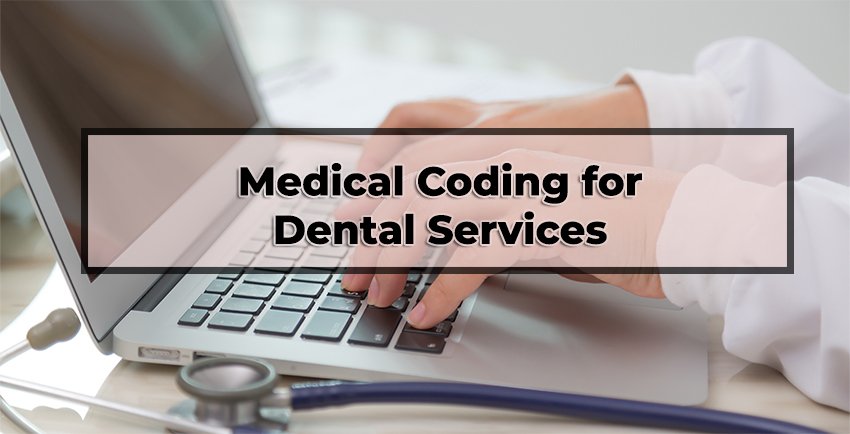Medical Coding for Dental Services
Dental services play a crucial role in maintaining oral health, which is essential for overall well-being. Regular dental check-ups, preventive care, and treatments such as fillings, root canals, and extractions help maintain healthy teeth and gums. Dental services extend beyond just treating dental issues; they can prevent more serious conditions such as infections, tooth loss, and even cardiovascular diseases linked to poor oral health.

Accurate medical coding for dental services is essential to ensure proper billing, reimbursement, and documentation of the care provided. Dental services use a combination of CPT (Current Procedural Terminology), CDT (Current Dental Terminology), and ICD-10-CM codes to capture dental procedures and diagnoses. Coders must be familiar with these coding systems and understand how they apply to both general dental care and more specialized procedures.
Key Components of Dental Services Coding
Dental services cover a broad range of treatments, including preventive care, restorative procedures, and surgical interventions. Each category requires specific coding to ensure that services are accurately documented and billed.
1. Preventive Dental Care:
Preventive care includes routine dental cleanings, exams, and X-rays, all aimed at maintaining oral health and preventing future dental problems. CDT code D0120 is used for periodic oral evaluations, while D1110 covers dental prophylaxis (cleanings) for adults.
Coders must ensure that preventive services are coded correctly to reflect the nature of the service, particularly if multiple services, such as a cleaning and an exam, are performed during the same visit.
2. Restorative Procedures:
Restorative dental procedures involve repairing damaged teeth or replacing missing teeth with fillings, crowns, bridges, or implants. CDT code D2391 is used for a one-surface posterior composite filling, while D2740 covers a porcelain crown on a tooth.
Coders must accurately document the specific tooth and surfaces involved in the restoration, as dental codes often include modifiers to specify the exact location of the treatment.
3. Oral Surgery:
Oral surgery includes extractions, biopsies, and other surgical interventions. For example, CDT code D7140 is used for a simple extraction of an erupted tooth, while D7210 is for surgical removal of a partially impacted tooth.
Coders must be aware of the complexities involved in oral surgeries, ensuring that the proper codes and modifiers are applied, especially when the surgery is more complicated.
Special Considerations in Dental Services Coding
Dental coding has several unique considerations, particularly when it comes to payer coverage and the interaction between medical and dental insurance. Some services may overlap between medical and dental coverage, requiring coders to be familiar with both systems.
Coordination Between Medical and Dental Coverage:
Some dental services, such as those related to trauma or congenital conditions, may be covered under medical insurance. For example, a tooth extraction due to an accident might be billed through medical insurance using CPT code 41899 (unlisted procedure, dentoalveolar structures), while routine extractions are typically billed under dental coverage.
Coders must determine which services are eligible for medical insurance coverage and which must be billed through dental insurance, ensuring that the correct codes and documentation are provided for each payer.
Medicare and Medicaid Guidelines:
Medicare typically does not cover routine dental care, but it may cover certain dental procedures if they are related to a medical condition or required for other medical treatments, such as preparing the mouth for radiation therapy. Coders must ensure that any services billed to Medicare meet the strict criteria for coverage.
Medicaid may offer more comprehensive dental coverage, especially for children. Coders must be familiar with Medicaid’s specific dental guidelines, as each state’s program may have different rules for coverage, limitations, and prior authorization requirements.
Challenges in Coding for Dental Services
One of the main challenges in coding for dental services is navigating the different coding systems. Dental services often require the use of CDT codes, but when the treatment overlaps with medical conditions, coders may also need to use CPT and ICD-10-CM codes. Coders must ensure that they understand the differences between these systems and apply the correct codes based on the service provided and the payer’s requirements.
Another challenge is managing the complexity of dental procedures. For example, restorative treatments often involve multiple surfaces or areas of the tooth, requiring the use of specific modifiers to indicate which tooth and which surface is being treated. Coders must be diligent in applying the correct modifiers to avoid errors and ensure accurate reimbursement.
Best Practices for Accurate Dental Services Coding
Thorough Documentation: Providers should document each dental procedure in detail, including the specific teeth and surfaces treated. Coders rely on this documentation to assign the correct CDT, CPT, and ICD-10-CM codes. Accurate documentation helps ensure proper billing and reduces the risk of claim denials.
Understand Payer Policies: Coders should familiarize themselves with the payer’s coverage policies, especially for services that may be covered by both medical and dental insurance. Understanding what each payer requires will help ensure that the correct codes and documentation are provided.
Use of Modifiers: Coders must apply modifiers correctly to indicate specific details about the dental service provided, such as the location of the treatment or whether it was a surgical or restorative procedure. Accurate use of modifiers ensures that the service is billed correctly.
Medical coding for dental services is an essential part of documenting and billing for preventive, restorative, and surgical dental care. Coders must understand the distinctions between CDT, CPT, and ICD-10-CM codes and how these codes apply to the wide range of services provided in dental care. Accurate coding ensures that providers are reimbursed for the services they provide while maintaining compliance with payer guidelines.
By staying informed about dental coding systems, payer requirements, and best practices, coders can help ensure that patients receive the care they need and that providers are properly compensated for their work. Whether coding for routine check-ups or complex dental surgeries, coders play a vital role in supporting the delivery of high-quality dental care.

